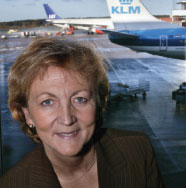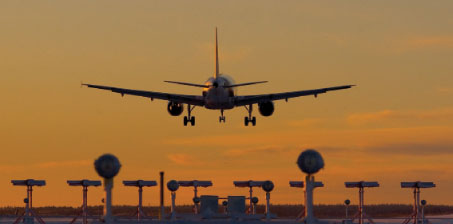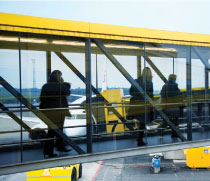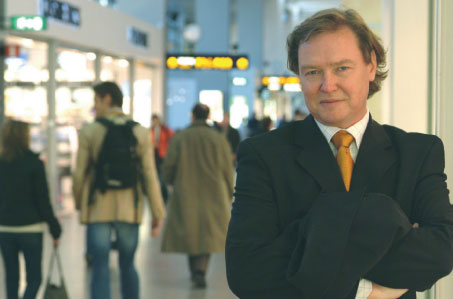
“It has certainly been a strength to be able to show the airlines that charges have been lowered in several consecutive steps. The ‘visit cost’ reduction has also made it possible to attract price-sensitive airlines, who would otherwise not have been able to take the risk of establishing themselves at the LFV airports,” said Kerstin Lindberg Göransson, managing director, Stockholm-Arlanda.
The latest reduction amounts to an annual drop of a further SEK 29 million (€2.8 million). It means that LFV has now lowered its prices by SEK 300 million (€29 million) since 2004.
The LFV Group applies a strategy whereby if traffic and financial goals are met or exceeded it reinvests in the business, primarily by reducing charges and other measures to stimulate the aviation market. “The reduction gives customers a fair view that we are willing to share risk in order to expand,” said Sigurdson. It is a policy undertaken with the aim of driving traffic and increasing the competitiveness of LFV’s airports, and it is of particular relevance in light of the forthcoming EU Directive on airport charges. Sigurdson explained that while the Directive is bound to have an effect on LFV, it is not influencing current strategy.
“The airport business has changed over a period of time – competition between airports is increasing and it is becoming more important for airports to be competitive,” said Sigurdson. Stockholm-Arlanda competes with Copenhagen and Helsinki for intercontinental traffic, for example, and a key element of the LFV strategy is boosting traffic in this area. It has enjoyed notable success – attracting carriers such as Malaysian Airlines, Qatar Airways, Delta Air Lines, Continental Airlines and US Airways to the airport.
“The other perspective is that LFV Group is a state-owned enterprise and the owners expect a certain return on capital – once we meet or exceed those goals, the choice has been made to reinvest in the business. There are two different angles to it,” said Sigurdson.

LFV Group has lowered its charges in several consecutive steps. On 1 November it applied a 9% reduction in charges at three of its airports – Stockholm-Arlanda, Stockholm-Bromma and Göteborg Landvetter. The latest reduction amounts to an annual drop of a further SEK 29 million (€2.8 million).
Increased competitiveness
The LFV Group went through its biggest ever investment programme around the turn of the millennium. The programme included a third runway and a new terminal pier at Stockholm-Arlanda, as well as a new air traffic control system. It became necessary to start recovering these costs when traffic declined after 9/11. The combined effect of substantial cost-savings and the traffic recovery that started in 2004 meant that the LFV Group was in a position to start reducing charges.
There are three main benefits to the strategy: First, airports are nowadays under competitive pressure; working actively on prices and price models increases their competitiveness. Second, a customer-oriented price strategy clearly helps in building relations with airline customers. Third, low costs have become an even more important part of airline business models during recent years. “The airport charges may, in particular for these airlines, be a factor that determines whether a route survives or not,” said Göransson.

Coupled with the reduction of airport charges is the work LFV does to stimulate inbound tourism to Sweden; it has allocated SEK 15 million (€1.5 million) per year towards this through its In-tourist Fund.
Airport charges are, naturally, an important issue when deciding where to put new aircraft capacity. “It has certainly been a strength to be able to show the airlines that charges have been lowered in several consecutive steps. The ‘visit cost’ reduction has also made it possible to attract price-sensitive airlines, which would otherwise not have been able to take the risk of establishing themselves at the LFV airports,” said Göransson. easyJet, for example, now operates services from Stockholm-Arlanda to Geneva and Milan-Malpensa.
The reduction in charges has had a positive effect on passenger development across LFV airports. Overall, throughput across the Group rose 5.5% in 2004, 4.6% in 2005, 2.7% in 2006 and 1.7% in 2007. Göransson forecasts 2% growth for 2008, but a 4% drop in passenger numbers in 2009. Demand is expected to fall as a result of the economic slowdown and the impact of the Sterling Airways bankruptcy in October. While Sterling did operate several routes out of Stockholm, LFV has not been affected in the same way as Copenhagen, which was Sterling’s main base.
As at Copenhagen, Norwegian is stepping in to take over some routes and Sigurdson expects that by 2010 LFV will not feel any effect of the Sterling bankruptcy.
Developing inbound tourism
In tandem with its reduction of airport charges, LFV is also involved in a number of collaborative strategies, aimed at stimulating inbound tourism to Sweden; the Group has allocated SEK 15 million (€1.5 million) per year towards this through its In-tourist Fund, which is used to generate more interest in Sweden as a tourist destination. This is, for example, being used to fund research and training in the field of tourism – an agreement for this was recently signed with the School of Business, Economics and Law at the University of Gothenburg.
For the 12 regional LFV airports outside the three largest metropolitan areas in Sweden inbound tourism is definitely the most promising segment for traffic growth. The LFV Group works constantly to intensify cooperation with national and local tourism agencies, as well as regional governments and major tourism product owners such as the Ice Hotel. “Regional cooperation is crucial for the development of inbound tourism at the smaller airports and an important competitive factor in the case of Stockholm, Gothenburg and Malmo,” said Göransson.

“LFV Group is a state-owned enterprise and the owners expect a certain return on capital – once we meet or exceed those goals, the choice has been made to reinvest in the business,” said Mats Sigurdson, vice president aviation marketing, LFV Airports.
Customer-oriented pricing strategy
As regards the future, no decision has been made regarding further price reductions, but the strategy is still in force, meaning that prices will be reduced, as long as the profitability requirement can be fulfilled, explained Göransson. This will undoubtedly help LFV maintain its competitive edge, in the midst of the current crisis, as low-cost carriers review routes.
There is clearly no ‘one-size-fits-all’ approach when it comes to airport charges as airports of different sizes, operating in different market environments and in different situations as regards capacity developments and capital expenditure, cannot follow the same pricing strategies. Nevertheless, LFV is yet another example of how airports have responded to market pressures in a positive and proactive way, increasingly sharing risk with airlines, allowing them not to pay the full cost of the infrastructure that they use.







